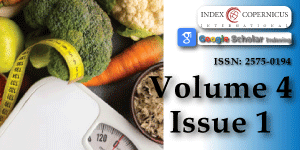Effect of ginger flour supplementation on fermented millet flour ‘ibyer’ anti-diabetic and biochemical properties
Main Article Content
Abstract
A mucoso-respiratory highly contagious disease; COVID-19, has led to tremendous global health and economy damages. This virus could be dampened through home use of fermented bio food material. Fermented millet flour (ibyer) is an indigenous non-alcoholic gruel made from cereals either (maize, sorghum and millet). It is prepared by cooking reconstituted cereal flour or wet milled paste with water. In this study, fermented millet fl our supplemented with ginger powder blends were formulated in the ratio 100:0, 95:5, 90:10, 85:15, 80:20, 75:25 and 70:30 for the production of gruel. The blends were subjected to feeding trial experiment using wistar albino rat. Results analysis revealed that Serum cholesterol was less than 200 mg/dl. The fasting blood glucose was also within the recommended range (67.7 - 125.0 mg/dl). The biochemical parameters were within recommended range, total serum protein ranged from 5.82-7.06 g/L, Alanine aminotransferase ranged from 28.53 to 41.13 iu/L, Aspartate aminotransferase ranged from 28.50 to 48.66 iu/L. The albino rats showed slight increase in body weight throughout the experimental period, ranging from 78.67 -103.80 g. The experiment shows that the diet did not have any adverse effect on the experimental animals and were within the recommended range hence a good anti diabetic blend and has excellent biochemical profile properties for homes use.
Article Details
Copyright (c) 2020 Adakole MI, et al.

This work is licensed under a Creative Commons Attribution 4.0 International License.
Wild S, Roglic G, Green A, Sicree R, King H. Global prevalence of diabetes: estimates for the year 2000 and projections for 2030. Diabetes care. 2004; 27: 1047-1053. PubMed: https://pubmed.ncbi.nlm.nih.gov/15111519/
Meyer K, Deutscher J, Anil M, Berthold A, Bartsch KW. Serum androgen levels in adolescents with type I diabetes: relationship to pubertal stage and metabolic control. J Endocrinol Invest. 2000; 23: 362-368. PubMed: https://pubmed.ncbi.nlm.nih.gov/10908163/
Ojewole JAO. Analgesic, antiinflammatory and hypoglycaemic effects of ethanol extract of Zingiber officinale (Roscoe) rhizomes (Zingiberaceae) in mice and rats. Phytother Res. 2006; 20: 764–772. PubMed: https://pubmed.ncbi.nlm.nih.gov/16807883/
Jafri SA, Abass S, Qasim M. Hypoglycemic effect of ginger (Zingiber officinale) in alloxan induced diabetic rats (Rattus norvagicus). Pak Vet J. 2011; 31: 160-162.
American Diabetes Association. Nutrition Recommendations and interventions for diabetes. 2009.
Hamden K, Carreau S, Jamoussi K, Miladi S, Lajmi S, et al. 1Alpha, 25 dihydroxyvitamin D3: therapeutic and preventive effects against oxidative stress, hepatic, pancreatic and renal injury in alloxan-induced diabetes in rats. J Nutrit Sci Vitaminol. 2009; 55: 215-222. PubMed: https://pubmed.ncbi.nlm.nih.gov/19602829/
Anju T, Sarita S. Suitability of foxtail millet (Setaria italica) and barnyard millet (Echinochloa frumentacea) for development of low glycemic index biscuits. Malyasian J Nutrit. 2010; 16: 361-368. PubMed: https://pubmed.ncbi.nlm.nih.gov/22691989/
Thathola A, Srivastava S, Singh G. Effect of foxtail millet (Setaria italica) supplementation on serum glucose, serum lipids and glycosylated hemoglobin in type 2 diabetics. Diabetol Croatica. 2010; 40: 23-28.
Singh J, Dartois A, Kaur L. Starch digestibility in food matrix: a review. Trends Food Sci Technol. 2010; 21: 168-180.
Venn BJ, Mann JI. Cereal grains, legumes and diabetes. Eur J Clini Nutrit. 2010; 58: 1443-1461. PubMed: https://pubmed.ncbi.nlm.nih.gov/15162131/
Annor GA, Marcone M, Bertoft E, Seetharaman K. in vitro Starch Digestibility and Expected Glycemic Index of Kodo Millet (Paspalum scrobiculatum) as Affected by Starch-Protein-Lipid Interactions. Cereal Chem. 2013; 90: 211-217.
Nicoll R, Henein MY. Ginger (Zingiber officinale Roscoe): a hot remedy for cardiovascular disease? Int J Cardiol. 2009; 131:408–409. PubMed: https://pubmed.ncbi.nlm.nih.gov/18037515/
Ali BH, Blunden G, Tanira MO, Nemmar A. Some phytochemical, pharmacological and toxicological properties of ginger (Zingiber officinale Roscoe): A review of recent research. Food Chem Toxicol. 2008; 46: 409–420. PubMed: https://pubmed.ncbi.nlm.nih.gov/17950516/
Sengev IA, Ingbian EK, Gernah DL. Sensory and storage properties of instant kunun-zaki: a non-alcoholic fermented sorghum beverage supplemented with mango mesocarp flour. Nigerian Food J. 2010; 28: 336-346.
Sekwati-Monang B, Gänzle MG. Microbiological and chemical characterisation of ting, a sorghum-based gluten-free fermented cereal product from botswana. 2011; 150: 115-121. PubMed: https://pubmed.ncbi.nlm.nih.gov/21862164/
Kure OA, Wyasu G. Influence of Natural Fermentation, Malt Addition and Soya Fortification on the Sensory and Physicochemical Characteristics of ibyer-Sorghum Gruel. Adv Applied Sci Res. 2013; 4: 345-349.
Al-Amin ZM, Thomson M, Al – Qattan KK. Anti-diabetic and hypolipidaemic properties of ginger (Zingiber officinale) in streptozotocin-induced diabetic rats. Br J Nutr. 2006; 96: 660-666. PubMed: https://pubmed.ncbi.nlm.nih.gov/17010224/
Shanmugam KR, Mallikarjuna K, Kesrireddy N, Sathyavelu RK. Neuroprotective effect of ginger on antioxidant enzymes in streptozotocin-induced diabetic rats. Food Chem Toxicol. 2011; 49: 893-897. PubMed: https://pubmed.ncbi.nlm.nih.gov/21184796/
Adekunle AA. Agricultural innovation in sub Saharan Africa: experiences from multiple-stakeholder approaches. Forum for Agricultural Research in Africa, Ghana. 2012.
AOAC. Official methods of analysis, Association of Official Analytical Chemists. 19th ed. Washington DC chapter. 2012; 33: 4-140 .
Bergmeyer HU, Scheibe P, Wahlefeld AW. Optimization of methods for aspartate aminotransferase and alanine aminotransferase. Clini Chem. 1978; 24: 58-73. PubMed: https://pubmed.ncbi.nlm.nih.gov/22409/
Black CD, Herring MP, Hurley DJ, O’Connor PJ. Ginger reduce Muscle Pain Caused by Eccentric Exercise. J Phytother Res. 2010; 11: 894-903. PubMed: https://pubmed.ncbi.nlm.nih.gov/20418184/
FAO/WHO. Human vitamin and mineral requirements FAO/WHO expert consultation on human vitamin and mineral requirement. 2001; 1-286.
Kaplan A, Laverne L. Szabo. Clinical Chemistry: Interpretation and techniques. 2nd Edition. 2003.
Kalui CM, Mathara JM, Kutima PM. Probiotic potential of spontaneously fermented cereal based foods: a review. African J Biotechnol. 2010; 9: 2490-2498.
Reitman S, Frankel S. Determination of glutamic-oxaloacetic transaminase. Am J Clini Pathol.1957; 28: 56-63. PubMed: https://pubmed.ncbi.nlm.nih.gov/13458125/
Smith DA, Baker BS, Gatti M. Mutationsin genes encoding essential mitotic functions in Drosophila Melanogaster. Genetics. 2011; 110: 647-670. PubMed: https://www.ncbi.nlm.nih.gov/pmc/articles/PMC1202585/
Shobana S, Malleshi NG. Preparation and functional properties of decorticated finger millet (Eleusine coracana). J Food Engine. 2007; 79: 529-538.
Taylor DJ. Effects of antibiotics and their alternatives. Br Poult Sci. 2001; 412: 67-687.
Zick SM, Djuric Z, Ruffin MT, Litzinger AJ, Normolle DP, et al. Pharmacokinetics of 6-gingerol, 8-gingerol, 10-gingerol, and 6-shogaol and conjugate metabolites in healthy human subjects. Cancer Epidemiol Biomarkers Prev. 2008; 17: 1930–1936. PubMed: https://pubmed.ncbi.nlm.nih.gov/18708382/

